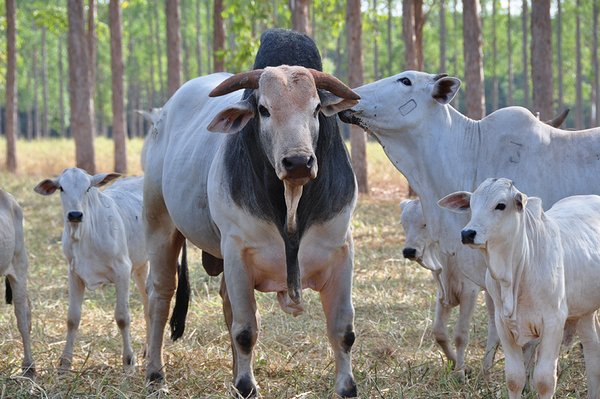 Download this article in magazine layout
Download this article in magazine layout
- Share this article
- Subscribe to our newsletter
Brazil’s approach to low-carbon agriculture
As always with this experiment, Orlando Lúcio de Oliveira Júnior, standing in the shade of an Inga tree, is looking forward to the sudden insight that he will now evoke among his visitors. The waist-high wooden frame standing in front of him holds three red plastic tubs, one next to the other and filled with the red soil typical of tropical regions. The tubs represent three agricultural systems: conventional farming, direct planting and integrated systems. At the front end of each vessel, a small downpipe feeds into a little round plastic dish. Using a watering can, de Oliveira Júnior now simulates the effect of a rain shower. A few seconds later, the dish with the sign reading “conventional farming” is full of red-coloured water. The water flows into the dish belonging to the “direct planting” system with a delay and is only slightly turbid. In the “integrated system”, the watering can has to be used a second time before the water even starts to fill the dish, coming out slowly and crystal-clear. Thus, the visitors can literally watch the evolution of soil conservation.
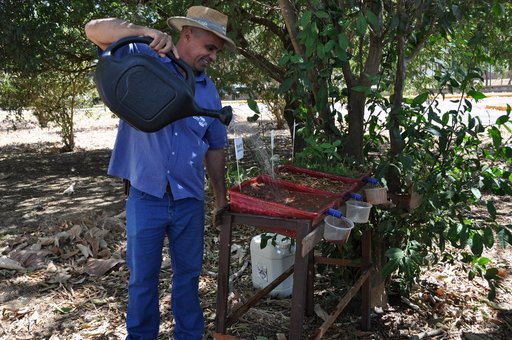
Orlando Lúcio de Oliveira Júnior demonstrating soil conservation in Embrapa's
employees orchard. Photo: Silvia Richter
Integrated production systems at the core
Orlando Lúcio de Oliveira Júnior is an analyst in the technical team of Embrapa Agrossilvipastoril, one of 43 research units run by the Brazilian Agricultural Research Corporation Embrapa. Located in Sinop in the Federal State of Mato Grosso, in the buffer zone between the Amazon and the Cerrado region (see Box at the end of article), this research centre, founded in 2009, concentrates on systems of integrated agricultural production – i.e. the scientific foundations of the analyst’s presentation. Within this strategy, different production systems are combined within the same area. It can be implemented as mixed cropping, succession cropping or crop rotation. Here, different combinations and hence intensities can be chosen: crop-livestock (ICL = mixed farming), crop-forest (ICF = agroforestry), livestock-forest (ILF) and crop-livestock-forest (ICLF).
These systems are part of the Low Carbon Agriculture Plan (Plan ABC+; see Box below), launched by the Brazilian Government in 2010. Its aim is the sustainable intensification of Brazilian agriculture. Greenhouse gas emissions are to be reduced while area productivity is to be simultaneously enhanced. Currently, more than 17 million hectares is under integrated management – according to ABC+, by 2030, it is to be 30 million hectares, with expansion above all taking place in regions with degraded pastures. After all, degradation affects 90 million hectares out of the 168 million hectares of the country’s pastureland.
Partnerships are key
“Most of our research is done through partnership,” says Laurimar Gonçalves Vendrusculo, who has been heading Embrapa Agrossilvipastoril since early 2022. In 2012, the ICLF Development Network was founded, a public-private partnership in which 19 Embrapa research centres throughout the country have joined forces with the agricultural cooperative Cocamar, seed merchants SOESP, the financial enterprise Bradesco and internationally operating firms such as John Deere and Syngenta to promote the introduction of integrated cultivation. The network supports 97 technological reference units across Brazil which are run by rural producers or institutions linked to a production sector in which an ICLF configuration has been adopted. These areas are monitored by the Embrapa technical team and are used to evaluate the technologies. Research and technology transfer – through field days, courses, technical visits and communication material – is financed via REM (REDD+ Early Movers) Mato Grosso (REDD = Reducing Emissions from Deforestation and Forest Degradation). The programme, funded by Germany, rewards efforts to reduce CO2 emissions through forest conservation actions. In Brazil, it is being implemented in two States: Acre (since 2014) and Mato Grosso (since 2017).
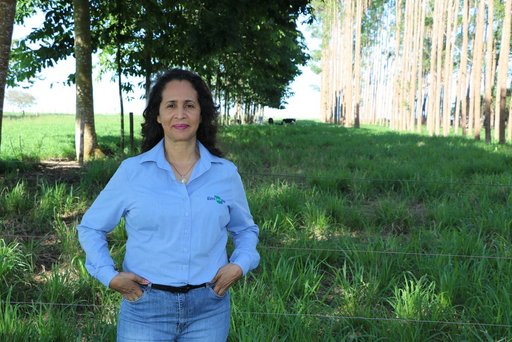
"Our research activities are committed to the SDGs", says Laurimar Conçalves Vendrusculo.
Photo: Gabriel Faria/ Embrapa
One of the Embrapa partners at farm level is the Fazenda Santiago, in the municipality of Sorriso, around 80 kilometres away from Sinop, and situated on Highway BR 163. Just like so many of their present professional colleagues, its owners, Luiz Fernando Paiva and Dudy Paiva, moved from Brazil’s economic and financial centre São Paulo to Mato Grosso in the 1970s, when the region was only little developed in terms of infrastructure. With their newly established farm, they first specialised in beef and dairy farming, only to enter crop production shortly afterwards – and already with the no-tillage system, which is now being practised in Brazil in a total area of 35 million hectares. “With our 1,500 hectares, we are a medium-sized farm,” the owners’ son Juliano Ribeiro Graça Paiva remarks. Properties of up to 500 hectares would be regarded as small, with farms from 3,000 hectares on counting as large.
Focusing on straw yield and pasture quality
With an area under cultivation of 10.46 million hectares, Mato Grosso is one of the country’s largest soy-growing regions; around 100 cultivars are available, with around five per cent of them GMO-free materials. As is customary in the Federal State, the first growing season – the rainy season from October to February, also known as safra – is devoted to this crop, which is grown on 1,100 hectares. In the second growing season (February/March – August/September, also referred to as safrinha), 750 hectares is dedicated to corn, while another 210 hectares is used for pastures for the 250 cattle. After the maize harvest, the cattle are kept on the harvested maize fields for three months. Signal grass (Brachiaria) is traditionally grown as cattle feed on the farm. In the tropics, it is a widespread grass family which produces a large mass of organic matter.
Via the research and technology transfer project with Embrapa, one aspect the family farm is testing is the suitability of various plant communities for the production of straw for the next soybean season in the no-tillage system. Here, comparing Brachiaria brizantha cv. Piatã in monoculture, various combinations of the grass are examined with cowpea beans (Vigna unguiculata), sorghum, radish (Raphanus sativus L.), sunflower, pigeon pea (Cajanus cajan), buckwheat (Fagopyrum esculentum), finger millet (Eleusine coracana) and stylo (Stylosanthes guianensis). A second experiment focuses on improving pasture quality in an integrated crop-livestock system, in which growing maize in monoculture is compared with various combinations of Brachiaria ruziziensis, Crotalaria spectabilis, forrage sorghum, grain sorghum, stylo, pigeon pea, radish, buckwheat and niger (Guizotia abyssinica).
“All the experiments start at Embrapa’s experimental field. The ones that have promising results then go to the farms,” explains Flávio Jesus Wruck, Deputy Head of Technology Transfer at Embrapa Agrossilvipastoril. The choice of species depends on the characteristics of the area and the historic of cultivation, and above all on the specific problems that need to be solved on the farm. Factors such as soil decompaction, nutrient uptake, nitrogen fixation or increase of soil organic matter are being analysed. With view to animal husbandry, factors such as nutrient content and digestibility of the forage or the reduction of soil nematodes are of interest.
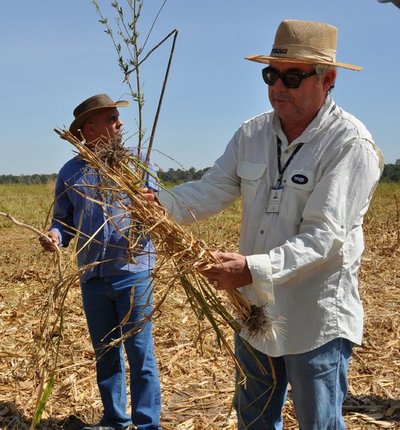
Flávio Jesus Wruck explaining the properties of different species.
Photo: Silvia Richter
The trials on the farm have not been completed yet, but there are promising initial results. In the plant consortia, not only has soil porosity been raised thanks to the plants involved bearing aggressive root systems, but more than ten tonnes of straw has been produced per hectare – this is more than the minimum that is needed to have a good covering of the soil in no-tillage systems. Moreover, it has been revealed that in a crop system with soybean production, 600 kilograms of carbon can be accumulated in one hectare of land. In addition, the straw’s nutrient content – phosphorus, potassium and nitrogen – has risen, the latter above all thanks to the use of legumes. “Considering the high price of fertilisers, this reuse of nutrients is an important economic factor for the farmers,” Wruck remarks.
Payments for responsible production
“With crop-livestock integration, we can increase productivity in a sustainable way,” says the farm’s junior manager. In numerical terms, he generates a per hectare yield of 3,600 kilograms of soy plus 6,000 kilograms of corn plus 60 kilograms of meat. “Combining the three products makes our farmers very competitive in the international markets,” adds Flávio Wruck. Certifying via the Roundtable of Responsible Soy (RTRS) forms a further income source for the farm. The main representatives of the soy value chain as well as civil society organisations are organised in this multi-stakeholder platform, which was set up in Zürich, Switzerland, in 2006. Every certified farm is audited once a year on the basis of 106 items concerning environmental and social standards. If it fulfils all criteria, it receives one RTRS credit for every tonne of soybeans. These credits can be traded via an online platform, and the price for them is 2–3 US dollars (USD) at the moment. Cristina Delicato of CAT (Clube Amigos da Terra/Friends of the Earth) NGO in Sorriso, which is a member of RTRS, has been campaigning for sustainable soy cultivation, environmental and forest conservation and family farming in the region for 20 years. She says that 180,000 hectares has been certified or is in the process of certification in the region – according to RTRS, the total for Brazil is just below 980,000 hectares. The purchasers of the credits are above all companies in Europe.
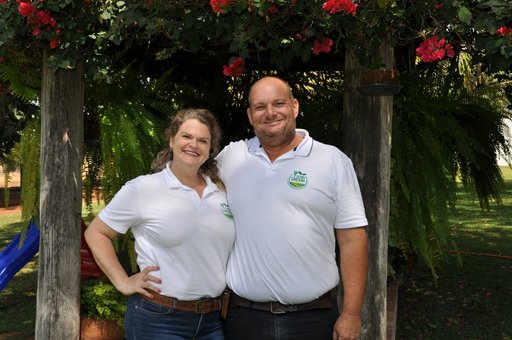
Juliano Ribeiro Graça Paiva and his wife Marcia Salete Becker Paiva.
Photo: Silvia Richter
A further step towards integration
Around 85 per cent of the Brazilian farms under integrated management have opted for the crop-livestock system. Things become ecologically and, above all, economically more interesting for the farms if they also integrate the third component – forestry. Here, Embrapa Agrossilvipastoril is running long-term trials with a wide range of combinations (ICF, ILF, ICLF), in order to recommend the most suitable configuration for the farmer – tailored to his goal (reforestation, income generation, thermal comfort of the animals, etc.) and type of utilisation (bioenergy, sawmill, etc.). So far, eucalyptus has been used as the sole tree component – thanks to its rapid growth and its large variety of uses, such as bioenergy, civil construction, fences or furniture, but also because the largest amount of silvicultural knowledge is available in this area. In addition, on the partnering farms and in the technological showcase of the research centre, further tree species are being tested, such as teak and African mahogany, whose wood is suitable for furniture, civil or naval construction, or the Brazilian nut, cashew or rubber tree. “Gliricidia could also be interesting, as the legume fixes nitrogen in the soil and can feed the cattle as well,” Embrapa forestry expert Maurel Behling says.
Some of the observations so far:
- In the integrated systems, the trees grow faster than in tree monoculture. Thanks to their standing further apart, they get more light, and there is less competition for nutrients.
- As integration increases, productivity rises in beef production. In the ICLF system, while maintaining optimum protein supply for the animals, and using 100 kilogrammes of NPK (nitrogen, phosphorus, potassium)/hectare, yields of 600 kilogrammes (300 kg meat) have been achieved per hectare, compared to around 450 kilogrammes (225 kg meat) per hectare under ILF and ICL management. For comparison, the average productivity in beef production in Mato Grosso is at 60 kilogrammes/hectare (30 kg meat).
- In the ICLF system, a milk production of 15 litres a day has been reached (average for Mato Grosso: 8 litres/day). The number of somatic cells is also lower in integrated systems.
- A comparison of timber yield in different integrated systems with beef production (9–10.5 cubic metres per hectare and year) with those in eucalyptus monoculture in the trials (34 m3/ha/year) and the Mato Grosso average (30 m3/ha/year) shows that in rough terms, it is possible to simultaneously produce a third of the timber yield from monocultures in an area with beef production. Here, it has to be considered that the production of wood depends on the number of trees per hectare, the layout of the system and the pruning and thinning management.
- Examinations regarding pests yielded mixed results. Whereas, for example, in eucalyptus monocultures, the caterpillar Glena unipennaria represented a problem, it did not occur among the trees in the ICLF system.
- A large variety of insects were observed in the ICLF system. However, these included both pests and beneficial species.
Carbon neutral meat and low carbon protocols
In the course of the Brazilian Government’s low-carbon strategy, Embrapa has established a partnership with Mafrig, one of the largest beef producers world-wide. In its context, the Carbon-Neutral Meat seal (Carne Carbono Neutro, CCN) has been developed, under which a handful of farms have so far been certified. It campaigns with the attributes “carbon offsetting”, “animal well-being” and “meat quality”. What this refers to is that thanks to their staying in the shade provided by the trees, the animals require less energy to regulate their body temperature. Furthermore, the pastures in the shade are more nutritious. The animals build up weight more quickly and can thus be slaughtered at a younger age. This means that per kilogram of dressed weight, less methane is emitted. Also, the meat of younger animals is softer. The farmers receive an eight per cent supplement for meat that is produced either in ILF or in ICLF systems. Moreover, Embrapa is about to finish the elaboration of a Low Carbon Meat Protocol in which cattle are considered that have been raised in integrated crop livestock systems, i.e. without tree integration. “We expect that this can be released next year,” says Wruck.
Measuring emissions intensity
To draw up this protocol, the researchers in Sinop measure greenhouse gas emissions from the different production systems as well as the potential of soils and trees as carbon sinks. Here, the methodology of the Guidelines for National Greenhouse Gas Inventories of the Intergovernmental Panel on Climate Change (IPCC) is employed. “The intensification of food production leads to higher productivity, but also to higher gas emissions. Thus, if we only analyse gas emissions and do not correlate these data with productivity, from the point of view of climate change, we arrive at the conclusion that intensifying is bad,” soil and plant nutrition expert Alexandre Ferreira do Nascimento explains.
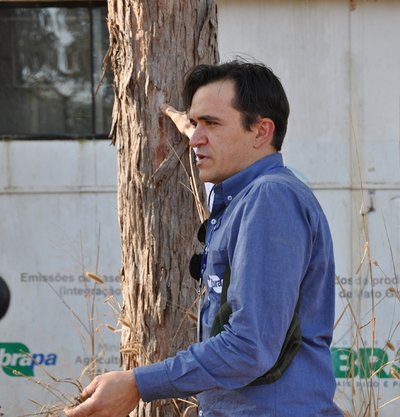
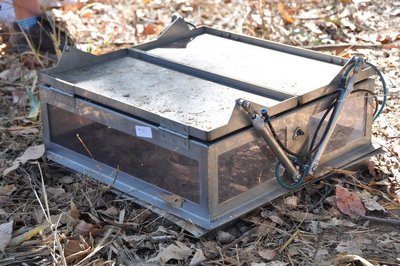
"We want to identify systems that manage to reconcile high productivity and lower emissions", says Alexandre Ferreira do Nascimento, explaining Embrapa's work on greenhouse gas dynamics.
Photos: Silvia Richter
This is why the emissions intensity of the different systems is examined. For the dairy systems, for instance, this means that all gas outputs – methane (CH4) from the animals, methane and nitrous oxide (N2O) from urine and dung, and N2O from nitrogen fertilisers – and all the carbon inputs (carbon stock in the soil and trees) as well as the milk production of the animals are measured. At the end of the project, all the emissions are transformed in terms of carbon equivalent in order to establish the kilo of carbon dioxide emitted per kilo of milk production.
The results of these examinations are yet to emerge, so that so far, no recommendations can be made. But what the scientists have found out in the course of examining N2O dynamics in the soil is that integrated systems with three products per agricultural year (such as soybean, corn and meat) do not lead to more N2O emissions from the soil than those systems with only one or two products per year. Furthermore, Alexandre Ferreira do Nascimento and his colleagues have established that under the climatic conditions in Mato Grosso, the emission factor for nitrogen fertilisers is not, as stated in the corresponding IPCC protocol, at 1 per cent, but at around 0.4 per cent.
All the research efforts centring on low-carbon agriculture are to help enhancing production in Brazil’s agriculture “without even one single tree being felled in the Amazon”, and ultimately help provide the farmers with more income. Or, as Embrapa President Celso Moretti recently put it at a branch event: “We want to have carbon as a fourth harvest.” To Laurimar Gonçalves Vendrusculo, working for the institute has another, very different value. “Each Real invested in research in 2021 gave a social return of 23.38 Reales to Brazilian society,” she emphasises.
Ecosystems and agriculture in Brazil
Brazil has an area of 8.51 million square kilometres. The territory is occupied by six biomes: the Amazon (49.3 %), considered the largest biological reserve in the world, the Cerrado (24 %), characterised by Savannah-type vegetation, which has been the main area of expansion of agricultural activity in recent decades, the Atlantic forest (13 %), which is located in the most densely populated region in the country, the Caatinga (9.7 %), a semi-arid region in the North-East with savannah-type vegetation, the Pantanal (2.1 %), considered the largest floodplain on the planet, and the Pampa (1,8 %), located in the extreme South, with typical steppe vegetation.
Around 30 per cent of the area is used for agriculture (21 % grassland, 7.8 % grain, 1 % planted forest), while roughly 66 per cent of the territory being occupied by native vegetation. Soy is grown in approximately 39.8 million hectares, making Brazil the world’s largest exporter of soy.
The country has more than five million farm businesses; according to data from the Agricultural and livestock Census of the Brazilian Institute of Geography and Statistics (IBGE), nearly 400,000 rural properties account for 85 per cent of the gross agricultural and livestock production. In the “Guidelines for the sustainable development of Brazilian agriculture” of January 2020, the Ministry states that “a significant portion of Brazilian rural farmers, especially small, medium and family producers, is excluded from the development that has taken place in Brazilian agriculture”.
The Brazilian Forest Code
In 2012, Brazil adopted its current Forest Code, which “seeks to reconcile environmental preservation with agricultural production in rural properties”. It stipulates that all rural properties have to maintain a minimum reserve area – referred to as the Legal Reserve – for native vegetation. The share of this area is 80 per cent in the Amazon, 35 per cent in the Cerrado and 20 per cent in the other biomes. The base for this is 2000 – legislation does not apply to farms which already existed earlier. Forest areas along the margins of the rivers and the tops of the mountains are viewed as permanent protected areas and must not be touched.
All farmers are obliged to register their land in the Rural Environmental Register (CAR – Cadastro Ambiental Rural), established with the Forest Code. If their documentation does not coincide with continuously updated satellite images, they have to take appropriate steps – otherwise they will be in for penalties. Those seeking to apply for bank credits have to submit the CAR entry as proof of their legal entitlement to the respective areas.
The Low Carbon Emission Plan
In April 2021, the Brazilian Ministry of Agriculture, Livestock, and Food Supply (MAPA) announced its Plan for Climate Change Adaptation and Low Carbon Emission in Agriculture, called ABC+. It covers the years 2020-2030 and follows up on the ABC Plan adopted in 2010. The latter stipulated targets for lowering CO2 emissions in various areas by 2020, which were to be achieved with six technologies: recovery of degraded pasture, Integrated crop-livestock-forestry systems (ICLFS), no-till farming, biological nitrogen fixation, planted forests and animal manure management. According to data from the Brazilian Ministry of Agriculture, sustainable agricultural technologies have been implemented on 59 million hectares through the ABC plan, which corresponds to a quarter of land under cultivation. Farmers applying corresponding technologies are granted low-interest credits.


